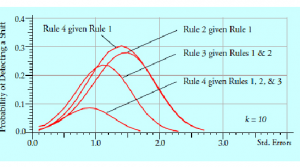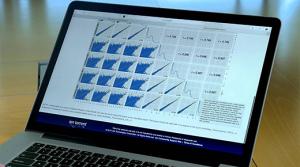
Mon, 10/09/2017 - 12:03
How do extra detection rules work to increase the sensitivity of a process behavior chart? What types of signals do they detect? Which detection rules should be used, and when should they be used in practice? For the answers read on.
In 1931, …
Tue, 09/05/2017 - 12:03
Sometimes we use a chart for individual values and a moving range (an XmR chart) to assess the homogeneity of a finite data set. Since this is an "off-label" use for the XmR chart, we first consider the drawbacks associated with using a sequential…
Mon, 08/07/2017 - 12:03
Last month I mentioned that we can put autocorrelated data on a process behavior chart. But what is autocorrelated data and what does it tell us about our processes? This article will use examples to answer both of these questions.
Autocorrelation…
Mon, 07/10/2017 - 12:03
The simplest type of process behavior chart is the chart for individual values and a moving range. It allows us to plot a point every time we get a value, making it perfect for data that occur one value at a time. A brief history of this simple…
Mon, 06/05/2017 - 12:03
In their recent article, “We Do Need Good Measurements,” Professors Stefan H. Steiner and R. Jock MacKay take exception to two of my Quality Digest articles, “Don’t We Need Good Measurements?” and “The Intraclass Correlation Coefficient.” While we…
Mon, 05/01/2017 - 12:03
Here we take a serious look at some nonsensical ideas about capability ratios. Following a quick review of predictability and capability and a brief discussion of the traditional ways of characterizing capability and performance, we will consider…
Mon, 04/03/2017 - 12:03
A recent question from a statistician in Germany led me to the realization that the F-test of analysis of variance (ANOVA) fame is in serious need of an update.
What the F-ratio does
The F-ratio, created by Sir Ronald Fisher around 1925, is a… The Three-Way Chart Some data structures need more than an average and range chart
Mon, 03/06/2017 - 12:03
The average and range chart handles most situations where the data can be logically organized into homogeneous subgroups. However, this chart breaks down when faced with a hierarchical data structure containing two or more levels of routine… Don’t We Need Good Measurements? Process behavior charts work with imperfect data
Mon, 02/06/2017 - 11:03
Good measurements are like apple pie and motherhood. Who could ever be against having good measurements? Since we all want good measurements, it sounds reasonable when people are told to check out the quality of their measurement system before…
Mon, 01/09/2017 - 12:01
What can be done when a test is destructive? How do we characterize measurement error? How can we determine if a test method is adequate for a given product or application? How can we check for bias?
All of the techniques for assessing the quality…